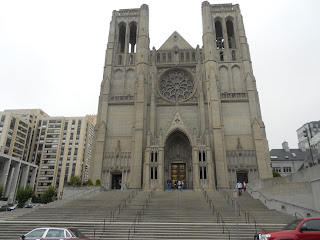There's always plenty to see in San Francisco. When you're making a list of things to see in San Francisco, Nob Hill is a must. Nob Hill is one of San Francisco's most prominent landmarks. The Nob Hill area of San Francisco is distinctive for several reasons. First, it's one of the forty-four hills in the city. Secondly, Nob Hill is one of the original "seven hills of San Francisco".
 |
| A view to downtown San Francisco from atop Nob Hill |
The Neighborhood of the Wealthy
When you visit Nob Hill one of the first things you'll notice are some of the spectacular views of the city and bay. This prime locale was one of the big reasons that the wealthy built their mansions on Nob Hill. The Nob Hill area came into being in the late 1800's when the city of San Francisco was growing rapidly. New neighborhoods were being created every year and would eventually reach westward all the way to the Pacific Ocean.
Interestingly enough, the earthquake and fire of 1906 brought along many changes. For one, many of the residents owning Nob Hill mansions that were destroyed during this event decided to relocate. Some moved to the Pacific Heights district.
 |
| Nob Hill's Fairmont Hotel |
Historic Hotels of Nob Hill
It's quite interesting just how the hotels on San Francisco's Nob Hill tell a story about both California and the city.
The Fairmont Hotel
One of the most well known hotels on Nob Hill is the Fairmont. Many have seen the facade of this grand hotel featured in movies and television over the years. The Fairmont Hotel was still in it's final construction stage when the great earthquake and fire of 1906 struck San Francisco. As a result, while the building itself remained intact, the interior was heavily damaged by fire and the hotel's opening was delayed a year until 1907. During this time the structure was also reenforced with concrete that could help it survive another earthquake. For those wondering how the hotel received it's name, it was named after U.S. Senator James Graham Fair. It so happened the hotel was constructed by his daughters, Virginia Fair Vanderbilt and Theresa Fair Oelrichs.
Today, the Fairmont stands out as one the most prestigious hotels in San Francisco. It is part of the Fairmont hotel and resort chain, a leader in the global hospitality industry.
 |
| Mark Hopkins Hotel |
Another well known hotel you've most likely heard of is the Mark Hopkins. The Mark Hopkins Hotel had a very different history than it's neighbor the Fairmont. The land where the Mark Hopkins sits was at one time the home of Mark Hopkins, one of the Big Four investors and founders of the Central Pacific Railroad. Historians will know that the Central Pacific was the railroad from California that connected with the Union Pacific train at Promontory Utah in May of 1869 creating the first true transcontinental railroad.
As it turned out, Mark Hopkins passed away in 1878 before his mansion was completed. Hopkins' widow lived in the house until her death in 1891. The property was eventually donated to the San Francisco Art Association which was to use it for a museum and school. The house, while still standing, was damaged extensively by the fire that followed the 1906 earthquake. Soon afterward, the property was bought by a mining engineer and investor who built the first hotel on the site. The hotel changed ownership in the 1960's and today is operated by the InterContinental Hotels Corporation. The Mark Hopkins Hotel is a California Historical Landmark.
An interesting side note is that three of the Big Four investors involved with founding the Central Pacific Railroad once had mansions on San Francisco's Nob Hill.
Links to other Western Trips photo articles about great stops near San Francisco's Nob Hill are the San Francisco Cable Car Museum, the USS Pampanito World War Two Submarine Tour and the old Spanish Mission Dolores.
Of special note is that the Cable Car Museum is just a few blocks north of Nob Hill and is a very unique place to visit. The museum is also an active cable car power house and car barn. In addition to viewing the many great artifacts and photos on display, you can also see the cable car system in action. See our link above for more information. The museum is located at the corner of Washington and Mason Streets.
Grace Cathedral
Grace Church, which predates Grace Cathedral, has it's origins back in the California Gold Rush era. The church was first built in 1849. Today's Grace Cathedral is erected on land which at one time was the home of Charles Crocker, one of the Central Pacific railroad's Big Four. Crocker's home was destroyed by the 1906 fire and he donated the property to the Epsicopal Diocese. Today, there are portions of Crocker's rear gate that are still visible.
Today, Grace Cathedral is the third largest Episcopal cathedral and the fifth largest Gothic-style cathedral in the United States. The present church building was built between the years of 1924 and 1964. Among the many works of art within Grace Cathedral is a very large display of work by Jan Henryk De Rosen. De Rosen was was a Polish painter and patriot who became famous for his mural and mosaic works. De Rosen lived between 1891 and 1982. The cathedral has sixty-six windows of stained glass. The cathedrals large organ has 7,466 pipes. It's a very unique and beautiful cathedral to visit.
(Photos from author's private collection)


